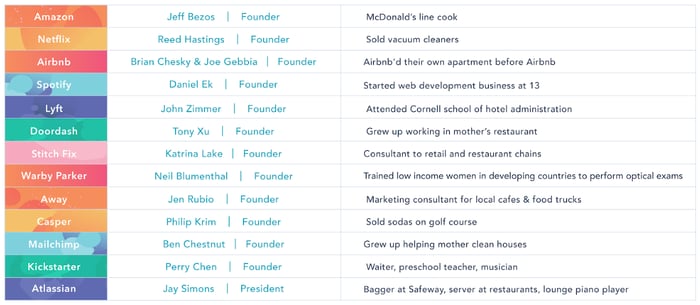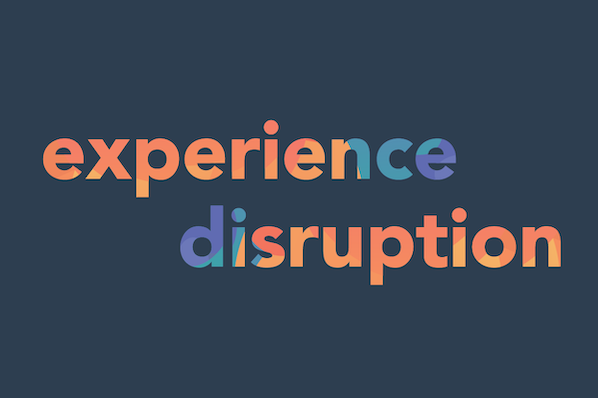I list all of these companies not to brand-drop, but to make a point. What do all these companies have in common? They make it incredibly easy on the customer to do business with them. You can’t find a speck of friction in their customer experience. My daily and nightly routine is seamless in large part due to these companies.
It’s not just consumer companies. In the B2B space, I’ve noticed a similar sea change of companies with the most frictionless and customer-focused experience taking over from incumbents because they provide a much better customer and user experience.
It’s not just a better experience -- they’re disrupting our very notion of what we as consumers should be able to expect from companies.

The Changing Nature of Disruption
The word disruption is ranked #3 on my list of most overused and under-understood words in business (wedged right between machine learning and blockchain).
“Disruption” is typically used to describe technology disruptions that turn industries upside down. When I first started in this industry these were the great tech leaders: Netscape’s browser, Google’s search engine, Intel’s chip, the iPhone, Tesla’s car. One thing they all have in common is the fact that there is some pretty deep and fundamental technology underpinning their business. In most of these cases, this technology was a real competitive advantage that was hard to overcome.
If you add up all the patents of these five companies, there are over 56,000.
But something has shifted, because the companies overthrowing incumbents today do not have deep technological advantages. For the most part, these companies’ competitive advantage isn’t due to technology innovation at all.
If you add up all of the patents for the companies I mentioned above that are infused in my daily routine, there are only about 500 between them.
So, if these companies aren’t technology disruptors, what are they?
I call them experience disruptors. These companies represent a new breed of growth leader that gets ahead by completely disrupting and reinventing the treatment we’ve come to expect out of companies as consumers.
Over the last six months I’ve dug into each of these so-called experience disruptors in my regular routine both in my home and business life. I used all their products, read all their terms and conditions, interviewed many of their founders and senior executives, and talked with their investors. All to understand what’s really happening here. What I found was really telling.
They come from hospitality roots.
The first thing you’ll notice about these companies is none of them really behave like traditional tech companies. They are genetically more similar to a great hospitality company like the Four Seasons or the Ritz-Carlton than to Oracle or Cisco.
In fact, I was surprised to hear that a lot of the founders have backgrounds in the hospitality industry. These roots create the foundation of how these leaders view the customer experience they’re trying to create, and that foundation shapes the culture of their teams and angle of their approaches.

They measure the experience, not just the product.
Most companies use metrics to understand how their products are working: purchases, uptime, usage, etc. But even in measuring the product, experience disruptors look to the experience of the product rather than just the feature functionality.
For example, payments software company Square doesn’t just measure the number of transactions it’s processing, it measures something it calls “the perfect swipe.” This is a blended metric that captures measures like time to complete transaction, percentage of successful swipes, and the time it takes for a receipt to arrive after the purchase is made. This is a far better reflection of what the end user experiences during the transaction.
They are secret shoppers of their own products.
Many Lyft executives sign up as drivers to understand the driver experience. Eric Yuan, CEO of Zoom is one of its heaviest users and feedback providers. In fact, he ran his entire IPO roadshow from an office using Zoom. He quite literally bet the success of his initial public offering on the strength, reliability, and experience of the product.
Using your own product in a broad and sweeping fashion inside your company gives you an empathy for the customer experience that no level of user research or persona-building can match.
They have moved from personas to people.
Speaking of personas, experience disruptors seem to put less stake in them than in the immense diversity of their audience. Stitch Fix CEO Katrina Lake has stopped using personas and instead uses data “clusters.” These clusters aren’t based on a limited collection of variables like age and size -- instead, they’re based on a living, endless set of data.
Similarly, Spotify stopped using personas and switched to use cases like “summer barbecue,” “PRIDE,” and “focus.” This setup enables them to adapt to the myriad of ways that people change and evolve their tastes in music.
They only charge for what you use.
The experience disruptors I studied all had ways to delight users by only charging them for what they use. They build trust by creating a one-for-one exchange and not letting packaging over-prescribe pricing. For example, Stitch Fix sends me a box with about $500 worth of clothes in it every month. I pick the stuff I want and the rest goes back to Stitch Fix. They charge me $20/box as a base fee, but any charge on top of that is only for what I keep.
Similarly, we use Slack in our offices at HubSpot. When we signed that contract, we estimated what we were going to need in terms of seats, but we found that if we didn’t use them, Slack would credit us the difference. This setup aligns incentives masterfully and makes renewals an easy decision.
They lean into cancellations and returns.
Pet product company Chewy is renowned for the grace and intelligence with which they handle returns and cancellations. Stories have spread around the internet of Chewy customers who have cancelled orders when their beloved pets passed away and found that not only was Chewy immediate in processing the cancellation, the company actually sent them flowers and heartfelt sympathy notes for their loss.
Additionally, when customers call to return items that don’t fit, Chewy sends them a replacement, but instead of processing the return, Chewy often encourages the customer to give the unwanted item to a friend. This is smart on multiple levels. First, it could cost more to process the return, and second, the item out in the wild might introduce a new prospective customer to the company.
They drop the middleman.
Part of making a better experience relies on being able to influence all of it. When you add in a distributor or retail channel, oftentimes you lose that control. So a number of experience disruptors have opted to skip the middleman and sell direct-to-consumer.
Away.com, Chewy, and Glossier all have built their businesses by cutting out the retail store and selling directly to people. We see this on the B2B side, too. You don’t sign up with WeWork through a commercial real estate broker. You get WeWork from WeWork. Experience disruptors own both the customer relationship and the channel that delivers it.
They see support as an opportunity.
The old view on customer support was to see it as a cost center -- an obligation the company needed to fill that didn’t really lead to business growth. Experience disruptors come at support from the opposite direction.
A great example of this is Tesla, which shifted its approach to support to align business goals and customer goals. Tesla noticed that customers were spending a lot of time waiting for repairs to be completed in their repair rooms. This is a bad experience for everyone. Most of the wait time was due to limited bay openings in the support center. They had two options: build more bays, or change their model. Looking at the common causes of repair requests, they realized that 80% of the cars coming in only needed 5-10 minute repairs. So, Tesla came up with a new approach -- send a mechanic to go fix the 5-10 minute problems in the car owner's driveway. This led to a greater efficiency in the company’s use of bays and a better experience for owners.
There is one more observation I want to spend some time on. This is really more of an underpinning of all of the experience disruptors we talked to in our research. Most companies fall victim to what I call the Tyranny of “Or.” They feel they have to choose between growing fast or growing well. Between pleasing investors or pleasing customers. Between investing in the product or investing in customer experience.
After talking with many of today’s leading companies, it’s clear to me how short-sighted this thinking is.
Rather than focus on the tyranny of “or,” experience disruptors lean into the audacity of “and.” The more you invest in customers, the more investors will be rewarded. The better you grow, the faster you’ll grow. The more you create a good customer experience, the better the product will get. They create a flywheel effect by focusing on the decisions they need to make to create the greatest customer experience, and that makes all the difference.
This is how we hope to grow as a business, today and in the years and decades to come. Today at INBOUND, HubSpot announced a slew of features and enhancements sourced directly from the customer base. Take a look, perhaps see something that you’ve requested, and keep sending feedback to make us better. Thank you.
Customer Centric Marketing


